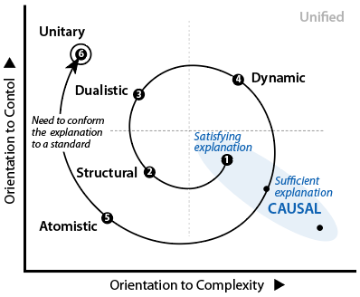Stage-6: Unitary Standards
![]() Reminder of the clarification process so far:
Reminder of the clarification process so far:
Communal Acceptance follows in the Unitary Mode
It is significant when many individuals autonomously commit to a sufficient explanation and accept that it fits the situation. By extension and appropriately generalized, the explanation would be applicable to similar situations.
At this point, the explanation is potentially a practical framework for all in determining whether change is appropriate with indications of how change might be pursued.
A personal confident assertion of such a framework and even its successful demonstration is not a form of validation that spreads easily. It may be persuasive in a face-to-face interaction or where a trusting personal relationship exists, but what is now needed is impersonal social dissemination that is meaningful to those who are doubtful.
The wider community requires some sort of guarantee which can only be provided by independent relevant standards that are unequivocal and, at least within that culture, call for conformity. Such standards will work if they are routinely used and respected.
Examples include:
- rules of evidence
- a current scientific paradigm
- relevant cultural ethic
- principles developed from related explanations
Application of such standards puts the sufficient explanation firmly into the social arena and controls its quality. This provides further and may naturally lead to some adjustment, extension or re-phrasing of the framework.
:
The is about clarification by imposing existing ethical or social standards: a process which is necessarily objective and which must be applied in a comprehensive fashion.
Values & Assumptions

Promoting Acceptability
![]() Desired Benefit: Social Conformity
Desired Benefit: Social Conformity
Handling the Group
![]() Participation: Promote Consensus
Participation: Promote Consensus
![]() Communication: Improve Coherence
Communication: Improve Coherence
![]() Individualization: Highlight Principles
Individualization: Highlight Principles
Channeling Your Functioning:
The that has proven itself so valuable in consulting services has the potential to resolve problems with purpose and value in wider society.
For example, AI systems can be programmed with explicit sets of values that influence decision-making processes and be including in the algorithms that dictate the AI’s behaviour. However, the concept of value being used does not adhere to the framework and therefore fears have naturally developed in relation to the further development of AI.
But how can this framework be made acceptable to AI researchers?
While it is easy to persuade individuals in face-to-face interactions of the strength and powerful of the framework, something more is required for wider society. This website has therefore been developed with a focus on diverse and well-established methods of validation, that are independent of any specific taxonomic investigation. These principles should persuade reasonable members of any community with a scientific ethos to give the framework a hearing and even to look into it more deeply in relation to their own efforts.
Limitations
The result here is the provision of a explanation of the situation that has, or at least deserves, group consensus. Such an account naturally does not deal with the small variations in situations and circumstances that are inevitably faced by particular small groups, families or organizations.
Settling at this Stage
There may not be multiple groups dealing with the same or similar situations. In that case, a general or majority view may well suffice and there is no felt need to seek further .
Transition
However, if there is a multiplicity of situations of that type, then any particular individual or small group that wishes to operate with the explanation in their particular situation may find themselves wishing to make adjustments in order to handle it better.
The mode that naturally provides for contextual adjustments is the .
This also fits the mode oscillation because the choice of context switches back to subjective with any adaptation necessarily being limited to that particular context.
![]() Ruling Out the Alternative Move
Ruling Out the Alternative Move
- Move to Stage-7: Unified Mode.
Originally posted: 30-Oct-2024.